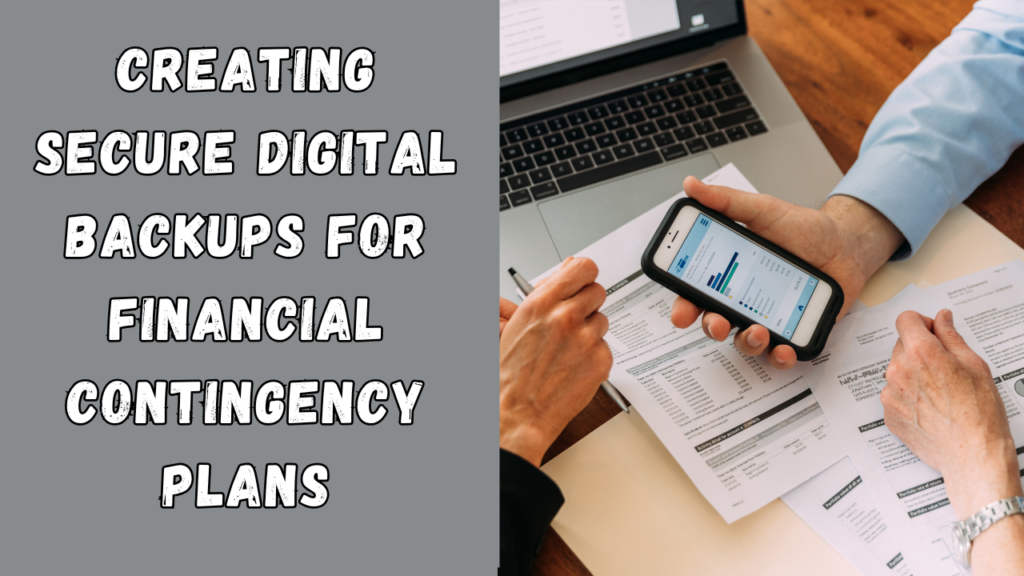
Creating Secure Digital Backups for Financial Contingency Plans
Writing Highlights
- Secure digital backups prevent financial data loss.
- Prioritize essential records like bank statements and taxes.
- Organize files systematically for easy access.
- Automate backups with cloud and external storage.
- Store copies in multiple secure locations.
- Keep editable formats for easy updates.
The need for financial certainty may arise from economic recession, cyber threats, or some unforeseen personal crises. Without sufficient contingency plans, both individuals and businesses may face risks of becoming financially unstable. A good plan will maintain access to key financial resources and minimize disruptions while sustaining long-term viability.
A critical part of financial contingency planning involves secure digital backups. Losing important financial documents like tax records, insurance, or investment records complicates proceedings, leads to delays, and causes monetary losses. Secured digital backups keep critical information safe and allow for rapid recovery in emergencies.
To ensure the protection and availability of data, digital backups must be encrypted, frequently updated, and kept at different secure locations. Another focus of concern is ensuring that access can be given without compromising security, which makes financial data immediately accessible when needed. By implementing a structured backup scheme for their resources, individuals and businesses may develop their financial resilience in such uncertain times.
Identifying Critical Financial Documents for Backup

Financial documents are, as a result, safe in a secure cloud solution but easily accessible any time they are required.
Essential Financial Records
A contingency plan for finances will only work with backup copies of the critical ones: the most important financial records to be backed up include the following:
- Bank Statement: These records reflect the income, expenditure, and balances maintained in the financial accounts. They are essential for planning finances, preparing a tax return, and resolving a dispute.
- Investment Portfolio: Backup documentation for stocks, bonds, mutual funds, and retirement accounts used to monitor financial growth and allow access when the market is variant.
- Insurance Policy: Copies of health, life, house, and automobile insurance policies, which are important for claim processing and emergencies.
- Tax Returns: Past tax returns serve as proof of income, decades-old proof of income, support loans, and audits.
Identification of Primary Secondary Financial Documents
All the financial documents do not carry the same importance level. Knowing the difference between the primary and secondary records will help better manage data.
- Primary Documents: These are critical documents needed for legal, financial, or emergency purposes. They include bank statements, investment reports, tax documents, and ongoing insurance policies.
- Secondary documents: Include invoices and old receipts, where available, and past versions of financial agreements. Though they serve a useful purpose, they do not have significance that will dictate an immediate decision.
By having the primary documents first, financial back-up remains lean and accessible.
Regularly Updating Backup Files
The nature of financial records is dynamic, making it all the more important for such records to be updated regularly. Failure to do so may result in the basis for financial planning to be wrong and many opportunities lost. According to the National Cyber Security Alliance, 60% of small businesses close within six months of losing their data. Therefore, regular digital backups will help minimize that risk and keep financial data available.
Automating and Updating Backups Regularly
The time-consuming character of manually backing up financial data and also mindlessly risking such data makes it imperative to automate the system. Scheduled automated backup processes guarantee the maintenance of data protection without risking lapses on the part of the operator. This ensures that contingency scheduling with digital backups can allow an individual or business to conduct uninterrupted operations while securing financially critical records.
Automated-Backup-Scheduling-Prevents-Data Loss
Automated backup solutions are put into place to curb the loss of financial documents in case of accidental deletion, cyber threats, or hardware failure. Data can be set to back up on cloud services or external drives daily, weekly, or monthly, depending on the importance of the document in question.
- Incremental vs. full backups: Full backups save thumb-sized copies of everything; incremental accepts a count of new files or modifies only any reduced required memory.
- Scheduling digital backups as per necessity: Daily for frequently updated financial records, weekly for bank statements, and monthly for tax-related documents. This guarantees efficiency without being too redundant.
- Using multiple storage options: Combining a cloud backup with an encrypted external hard drive for an added layer of security.
Ensuring Access Without Security Breaches
Backups must be locked, but they should also be able to be accessed when needed. This is quite well; the compromise between the two opens the way for one to have financial records while risking unauthorized exposure to them.
- Multi-Factor Authentication (MFA): Simply enabling MFA on cloud storage is an added layer, but nothing in the way of convenience.
- Role-based access control: Access limitation according to user roles is designed so that only authorized individuals can view sensitive data or modify it.
- Emergency recovery procedure: Well-defined steps to retrieve backups during a crisis to avoid delays when making financial decisions.
Testing Backup Systems for Reliability
- Regular testing of backup systems: Ensures their capability to function on demand, as mere storage of data is not enough, files have to be restored without corruption verification.
- Simulating data recovery scenarios: Periodic testing reveals all faults before a real emergency occurs.
- Testing backup completion logs: The checking of all scheduled backups running within parameters without faults to minimize gaps in stored data is ensured.
- Upgrading security parameters: Since there is an added evolution of cyber threats, the present changing needs should warrant the updating of backup systems with new encryption and protection protocols.
Securing Digital Backups Against Cyber Threats
To ensure protection from cyber threats, the digital backups must be protected for financial security. Once again, without the proper barriers, financial data are left exposed to breaches, unauthorized access, and corruption. Strong security ensures that important financial documents remain intact and can be accessible only to authorized users.
Avoiding Common Mistakes Like Weak Passwords and Unprotected Access
Most security breaches arise from weak passwords or lack of access control. Ways to ensure security are:
- Using strong and unique passwords for each backup storage account – the password manager helps generate complex passwords and store them.
- Enforce role-based access control (RBAC) to restrict access to financial backups for viewing, editing, or restoration.
- Do not store your password and encryption key in an easy-to-find place, such as email or unprotected documents.
Unauthorized Access Monitoring and Data Breach
Regular auditing of backup operations will help in detecting potential odd behavior and prevent data loss. The methods to be put in place are:
- Set alerts for unusual login attempts or unauthorized access.
- Periodically review access logs for unauthorized changes.
- Use security applications that can detect or prevent malware and ransomware attacks against backup files.
Backing Up in a Secure and Redundant Manner
A single backup location will surely not be enough to mitigate cyber threats. Disperse financial backups through many secure locations:
- Employ a combination of cloud storage with end-to-end encryption and offline external drives that are stored in secure environments.
- Public cloud storage should not be relied upon solely, without additional security measures. Instead, private cloud storage should be considered for sensitive financial data.
- Maintain at least one cold backup (not connected to the internet), which renders it impossible for ransomware attacks to encrypt all backups.
Updating and Patching Backup Systems Regularly
Cyber threats are always evolving; thus, the only way to protect it is to regularly update the backup systems:
- Keep backup software and cloud storage platforms updated with the latest security patches.
- Destroy the obsolete financial digital backups that no longer serve a purpose and accentuate threat exposure.
- Perform periodic integrity checks of a backup to ascertain if the files are intact and accessible.
Converting and Managing Financial Documents Efficiently
Edits to maintain accurate financial records, efficient conversion tools, and a structured file management system will have both individuals and businesses ensuring the accessibility, accuracy, and security of their financial documents on all platforms.
Importance of Maintaining Editable Versions of Critical Documents
Most updates to financial records are usually connected to one of their uses: as they are for tax, budget, or investment purposes. Non-editable documents such as PDFs make it cumbersome and time-consuming to effect changes in modifying such records. Keeping them editable will facilitate timely revision of changes without the need to start a document from scratch. Furthermore, editable formats lend themselves to easy entries of data and much smoother collaboration with other persons and are much more conveniently used along with financial planning tools.
Streamlining Document Conversion for Quick Update
It seems that PDF is a favorite format among financial people since it is fixed and can be opened from any device at all. Editing such formats is indeed difficult without the help of a trusty converter, which is where I love PDF to Word becomes useful, as it enables smooth conversion of PDF files into Word documents making editing possible.
Keeping the Document Formats Open for Accessibility Across Devices
A well-organized backup system of finances can allow access to documents via different devices computer, tablet, even phone. This is to say that saving files under commonly recognized formats such as PDF and Word will keep accessibility intact without the trouble of compatibility issues. Above all, it allows access to documents and all financial files whenever and wherever the need arises.
Setting Up a File Management System
Setting up a system for organizing files will help in managing financial documents easily. An example would be tax files, bank records, and account summaries under any one category. Naming conventions should also be simple, and consistent, with timestamps for versioning and tracking. This is meant to minimize confusion and eliminate using outdated records in making crucial financial decisions.
Verification and Regular Updating of Digital Copies
Updating financial documents is, in fact, as critical as backing them up. Outdated records could lead to defects in financial planning, wrong filings, or miscalculations. Setting periodic reminders to check files for their updates will ensure their cropping up in current data. Verifying therefore the state of digital copies would save important files from corruption or accidental loss.
Ending Remarks
For financial contingency planning to be effective, a safe mode of maintaining backup records must be utilized. By identifying key financial documents and systematically keeping them with regular updates, individuals and firms can protect important records against loss or any cyber threats. Security may be further heightened by the use of scheduled backup systems together with encryption and multi-factor authentication access, hence making them less cumbersome during retrieval. On the other end, efficient procedures for document conversion and management allow financial records to remain editable and usable whenever the need arises. A fully-fledged approach to the digital backup process provides an opportunity for financial fortitude and readiness during trying times.






Acheter Cialis 20 mg pas cher: cialis generique – Acheter Cialis 20 mg pas cher tadalmed.shop